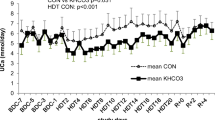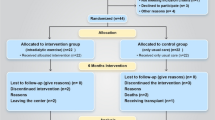Abstract
Measuring calcium (Ca) absorption, Ca balance and Ca level in serum,feces and urine during HK (hypokinesia) with and without Ca loading, the aim of this study was to disclose if prolonged HK could reduce Ca deposition more with or without Ca load contributing to greater Ca imbalance. Studies were conducted during 30-days pre-HK and 364-days HK. Forty male normal volunteers 23.7 ± 6.0 years of age were chosen as subjects. They were divided into four groups: unloaded active control subjects (UACS), unloaded hypokinetic subjects (UHKS), loaded active control subjects (LACS), loaded hypokinetic subjects (LHKS). All hypokinetic subjects were walking average distances of 0.5 ± 0.2 km day−1, and active control subjects were running average distances of 6.6 ± 1.2 km day−1. LACS and LHKS were loaded with 1.3 mmol calcium lactate/kg body wt. Before Ca load, fecal Ca loss, urinary Ca and phosphate (P) losses, Ca imbalance, serum ionized calcium (Ca I ), P and total Ca (Ca t ) levels increased significantly. (P < 0.05) with time, and serum intact parathyroid hormone (iPTH), 1.25 dihydroxyvitamin D (1.25(OH)2D3) levels and Ca absorption, decreased significantly (P < 0.05) with time in LHKS and UHKS compared with their pre-HK values and their respective active controls (LACS and UACS). After Ca load, however, Ca absorption, serum iPTH and 1.25 (OH)2D3 levels decreased significantly (P < 0.05) more with time, while fecal Ca loss, urinary Ca and P excretion and Ca imbalance increased significantly (P < 0.05) more with time in LHKS than UHKS. Conversely, before and after Ca load, fecal Ca excretion, urinary P and Ca loss, serum CaI, P, Ca, iPTH and 1.25 (OH)2D3 levels, Ca absorption and Ca balance did not change in LACS and UACS compared with their pre-HK values. The greater Ca losses with than without Ca load have shown that the more Ca is consumed the more Ca is eliminated during HK and Ca imbalance. The significant increase of Ca loss with Ca imbalance demonstrated reduced Ca deposition. Dissociation between Ca loss and Ca imbalance demonstrated reduced Ca deposition as the mechanism of Ca imbalance development during HK.
Similar content being viewed by others
References
Krotov VP. Kinetics and regulation of fluid and electrolytes metabolism in animals and human beings during prolonged hypokinesia, PhD thesis, “Interkosmos” Council, Academy of Sciences USSR and Directorate of Kosmic Biology and Medicine, Ministry of Health USSR, Moscow, Russia, 1978.
Volozhin AV. Pathogenesis of disturbances of calcium metabolism in mineralized tissue during long-term hypokinesia, PhD thesis, “Interkosmos” Council, Academy of Sciences USSR and Directorate of Kosmic Biology and Medicine, Ministry of Health USSR, Moscow, Russia, 1978.
YG Zorbas YF Federenko KA Naexu (1994) ArticleTitleCalcium loading and renal function in trained subjects during restriction of muscular activity and chronic hyperhydration. Biol Trace Elem Res 411 137–156
YG Zorbas VJ Kakurin NA Kuznetsov et al. (2000) ArticleTitleMeasurements in calcium supplemented athletes during and after hypokinetic and ambulatory conditions. Clin Biochem 33 393–404
YG Zorbas KP Charapakhin VB Afonin et al. (1999) ArticleTitleSerum, urinary and fecal phosphate changes in athletes during periodic and continuous restriction of muscular activity. Nutrit Res 48 72–97
YG Zorbas YF Federenko KA Naexu (1995) ArticleTitlePhosphate loading tests influences on endurance trained volunteers during restriction of muscular activity and chronic hyperhydration. Biol Trace Elem Res 58 51–65
YG Zorbas YY Yaroshenko NK Kuznetsov et al. (1997) ArticleTitleBone histomorphometric changes in trained subjects during prolonged restriction of muscular activity and chronic hyperhydration. Panminerva Med 38 265–274
Zorbas YG, Kakurin VJ, Kuznetsov NA et al. Bone mineral density in athletes during prolonged hyperhydration, hypokinesia and ambulation, Acta Astronaut, in press.
Author information
Authors and Affiliations
Rights and permissions
About this article
Cite this article
Zorbas, Y.G., Kakurin, V.J., Kuznetsov, N.A. et al. Calcium absorption measurements in normal subjects in determining calcium deposition during prolonged hypokinesia and with and without calcium loading. Int Urol Nephrol 36, 293–302 (2004). https://doi.org/10.1007/s11255-004-0929-7
Issue Date:
DOI: https://doi.org/10.1007/s11255-004-0929-7




